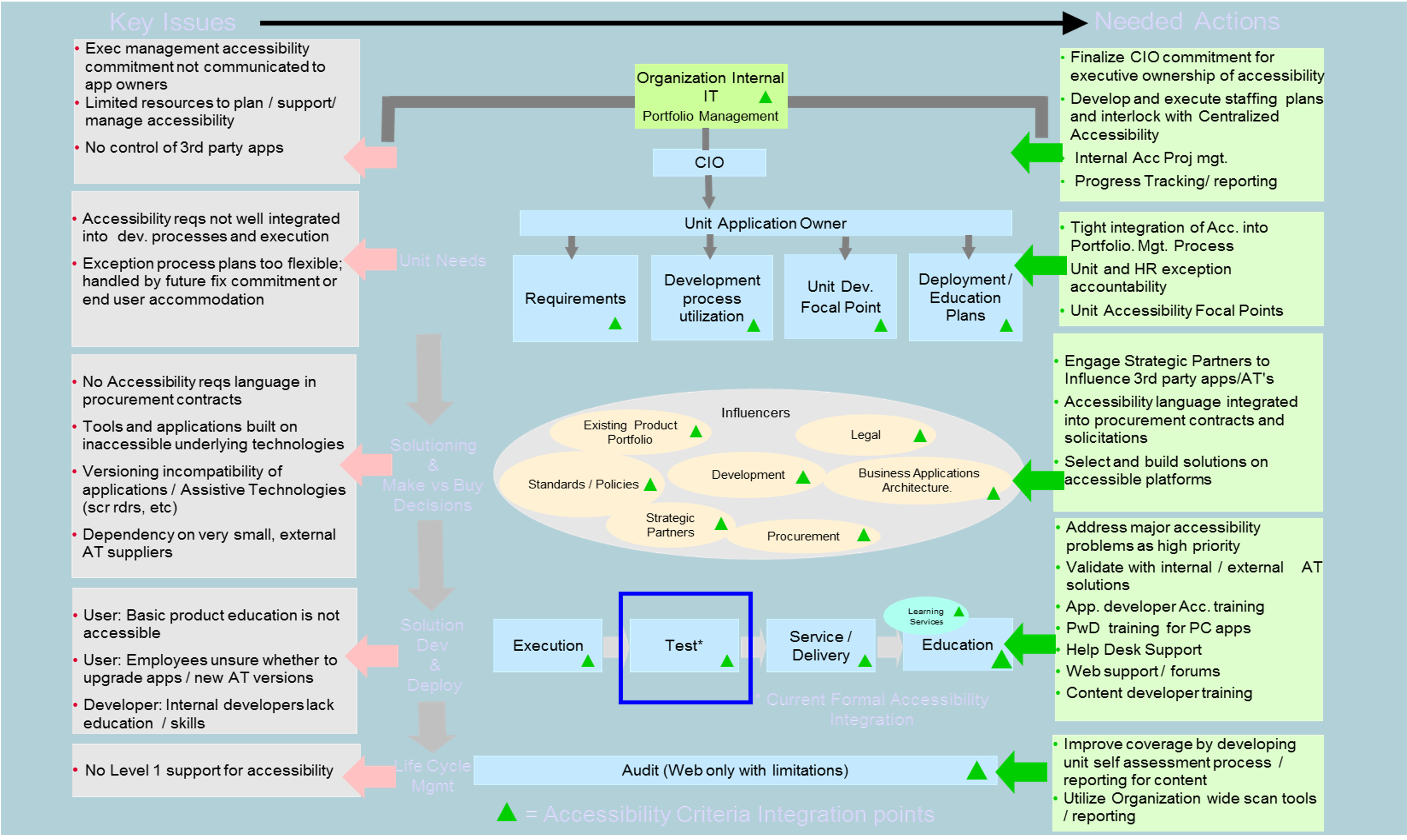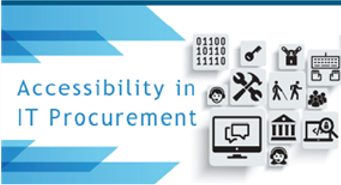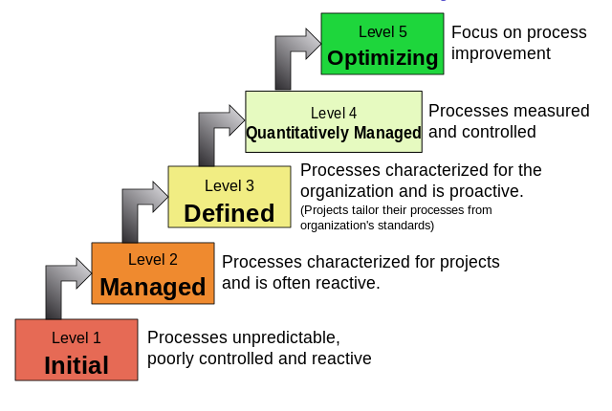Helping Organizations Make the Digital World Accessible Strategically
IT Accessibility = Inclusion for Everyone
IT Accessibility is an imperative and no longer an option and inaccessible IT is considered discriminatory which carries risk.
It touches many areas of an organization and requires a holistic approach to achieve full IT accessibility compliance and organizational maturity.
Is your organization a "yes" to the 3 questions below? If not, we can help.
Is Your Organization's IT Accessible to People with Disabilities?
Is your organization aware of accessibility regulations and standards that may apply to its products, services, and internal IT? Does it understand the risks of inaccessible IT and the benefits of accessible IT? Is there an IT accessibility program in place to deal with the complexities of IT accessibility in its offerings and internal IT environment?
In creating and implementing plans to ensure that an organization's IT products, services, and internal IT are accessible, there are multiple dimensions, many of which create significant challenges for an organization... large or small, public or private.
To be successful in dealing with IT accessibility in its entirety, a comprehensive, holistic approach is needed. It requires re-thinking of key business processes and policies, and the integration of IT accessibility at the appropriate points within organizations so that it becomes woven into the fabric of its business and culture.
Does Your Organization Have an Accessibility Policy and Governance System?
Establishing a successful IT Accessibility Program is not a trivial task. There are a mix of moving parts, and the initiative requires a top-down approach with commitment from organization leadership.
Every organization is a unique entity in structure and culture. This can create roadblocks for an organization’s accessibility maturity objectives due to diverging internal political agendas, parochial decision making, funding allocations, and the lack of overall commitment to a program.. just to name a few.
Individual staff and management may come and go for any and every reason, taking with them institutional knowledge, experience, and skills. Therefore, relying on one or even several individuals without overall guidanceis an approach known to be fraught problems, both operationally and politically.
The solution is robust IT accessibility policies and governance systems that ensure continuity and perpetuity of the program over the long term.
Without a robust accessible policy and accompanying governance system, the odds of success are significantly reduced.
Does Your Organization Ensure That IT Accessibility Compliance is Integral to IT Procurements?
FACT: Most of the IT deployed by organizations for external or internal use today is procured from 3rd parties. The bulk of these procured IT products and services are not in compliance with IT Accessibility standards.
Given this large dependency on procured IT, and the low levels of 3rd party compliance, thoroughly addressing accessibility in IT procurements must be a high priority when selecting IT offerings and awarding IT contracts.
Understanding the level of accessibility of procured products / services for compliance can be difficult, as there many IT products and services offered do not have credible / accurate accessibility documentation.
This gap in understanding of IT Accessibility from organization procurement teams in can result in uninformed or naive decision making that
- Creates barriers to access in the use of procured products / services
- Disenfranchises and denies opportunities to people with disabilities
- Spawns potential legal actions for discrimination
Prevention of such issues resides in the proper training of staff on accessibility in IT procurement, proper guidance / support documentation, and the integration of IT accessibility requirements throughout the procurement life cycle. With these tools under an organization’s belt, it can more confidently ensure that it is making the best decisions possible for procuring accessible IT products and services.

IT Accessibility Policy and Governance Systems
A well developed and implemented IT Accessibility Policy is the foundation that provides a "tops down" framework to a comprehensive, successful program.
Our services include analysis and recommendations for existing accessibility policies, or the development of new accessibility policy where none exists. Our end to end approach is acheived through close engagement throughout the entire process with client decision makers and staff to understand existing governance systems and the organization culture.
IT Accessibility Process Integration
The inclusion of IT accessibility in business processes helps ensure that needed IT accessibility activities happen as a matter of course, rather than through dependency on individuals who may or may not be there in the future.
We work with our clients to identify and understand their key business processes, analyze them for deficiencies in IT accessibility criteria, and propose process changes or new processes needed to close the gaps.


Accessibility In IT Procurement
Procured IT represents the largest part of an organization's IT asset portfolio. Inaccessible procured products carry with them significant risk to the organization.
We work closely with clients to analyze current IT procurement type workflows and identify gaps in these workflows. Then we modify / develop improved workflows, procedures, assessment tools and procurement document language for use in IT solicitation and contract templates.
IT Accessibility Risk Assessment
We perform IT accessibility risk analysis of your current IT portfolio and assess client organization's IT Accessibility maturity and provide recommendations for next steps to mitigate risk and improve the accessibility posture of deployed and planed IT.


IT Accessibility Organizational Maturity Assessment
We perform client IT Accessibility maturity assessments to identify gaps across relevant areas of the organization and provide strategic services and recommendations for improving the accessibility culture, driving of higher accessibility compliance levels over the long term.

Strategic IT Accessibility: Enabling the Organization 2nd Edition approaches IT Accessibility from the business side. It deals with the enablement of an organization rather than the technical enablement at a coding level. Unlike the typical piecemeal approach used by many organizations today, this book provides those in both the private and public sector with a strategic view of IT accessibility through an understanding of the diversity of moving parts and what is needed to enable and maintain them from program initialization and over the long term.
The book documents and leverages intellectual capital I've acquired in IT accessibility business transformation over the past 2 decades and provides straightforward guidance to organizations ready to embark on such a journey, but who struggle how to approach such an endeavor.
“Whether you’re a professional in accessibility or not Strategic ITAccessibility… is an important read for organization leaders or individuals working towards building an inclusive environment. Kline offers practical insights on integrating accessible technologies into the skeleton of every organization.”— Christopher Lee, Ph.D., IAAP VP Business Development & Managing Director
“Strategic IT Accessibility provides a compelling first look at how organizations should address the business and organizational issues of accessibility in a systemic fashion, providing both the information and insight needed by enterprises to move from laggards to leaders in the field.” — Timothy Springer, managing director, Level Access
“I was amazed by how spot on this book is in addressing accessibility in the corporate culture, with a plan that can really make a difference. Going forward I will be sure that every new client I work with has Jeff’s book.”— Dr. Jim Thatcher, JimThatcher.com
“Those of us who advise others on accessibility can use this excellent primer to help clients understand what is needed to instill the culture of inclusive technology in public or private sector organizations.”— Sharron Rush, Executive Director, Knowbility, Inc.
“Our industry has needed a book like Strategic IT Accessibility for a long time. When we started working with clients to include IT Accessibility at the strategic and process level, we noticed that the ROI soared. Many thanks to Jeff Kline for writing a book that is a must-read for any organization that wants to assure everyone has access to their services and products.”— Debra Ruh, founder and CEO, TecAccess, and chief marketing officer, Ruh Global Impact
-
Austin TX
-
+1 512.426.9779
Sign up to stay in the loop about the latest updates

Jeff Kline is a strategic accessibility consultant and author of "Strategic IT Accessibility: Enabling the Organization-2nd Edition". He is an invited expert for the W3C and a recognized subject matter expert in key areas of IT accessibility that include policy, rulemaking, process integration, procurement and risk mitigation. His client base includes public and private sector organizations. He served as Program Director of Statewide Electronic and Information Resources (EIR) Accessibility at the Texas Department of Information Resources, and consults on IT accessibility policy matters for international standards bodies, federal agencies, NGOs, and accessibility certification bodies. Prior to his government position in, Mr. Kline managed IBM''s Worldwide Accessibility Consulting and Business Transformation initiatives, and held other management positions in research and product development during his 26 year IBM career including design management, industrial design, operating system UI development, and system usability.
